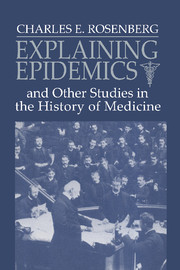Book contents
- Frontmatter
- Contents
- Acknowledgments
- Introduction: Why care about the history of medicine?
- I Ideas as actors
- II Institutions and medical care
- 7 The practice of medicine in New York a century ago
- 8 Social class and medical care in nineteenth-century America: The rise and fall of the dispensary
- 9 From almshouse to hospital: The shaping of Philadelphia General Hospital
- 10 Making it in urban medicine: A career in the age of scientific medicine
- III The past in the present: Using medical history
- Index
8 - Social class and medical care in nineteenth-century America: The rise and fall of the dispensary
Published online by Cambridge University Press: 29 March 2010
- Frontmatter
- Contents
- Acknowledgments
- Introduction: Why care about the history of medicine?
- I Ideas as actors
- II Institutions and medical care
- 7 The practice of medicine in New York a century ago
- 8 Social class and medical care in nineteenth-century America: The rise and fall of the dispensary
- 9 From almshouse to hospital: The shaping of Philadelphia General Hospital
- 10 Making it in urban medicine: A career in the age of scientific medicine
- III The past in the present: Using medical history
- Index
Summary
Like many of these chapters, this one was conceived in a moment of celebratory inadvertence – as a contribution for a symposium honoring Richard H. Shryock, pioneer historian of American medicine. I used the occasion to explore the rise and fall of the outpatient dispensary, an institution that had been central to the delivery of health care in America's growing cities – but which had been largely ignored by historians of medicine. I had first become aware of the dispensary's centrality – both to the medical profession and to urban working people – when completing research for Chapter 7, on mid-nineteenth-century New York. That essay emphasizes the pivotal interdependence between the internal history of the medical profession and the development of urban social institutions. But my interest remained latent as I worked on a variety of unrelated topics in the late 1960s and early 1970s. The focus of the Shryock symposium on social history provided an ideal incentive – and occasion – to pursue this relationship in another context.
To most mid-twentieth-century physicians, the term dispensary evokes the image of a hectic hospital pharmacy. To their mid-nineteenth-century counterparts, it was both the primary means for providing the urban poor with medical care and a vital link in the prevailing system of medical education. These institutions had an effective life span of roughly a hundred years.
- Type
- Chapter
- Information
- Explaining Epidemics , pp. 155 - 177Publisher: Cambridge University PressPrint publication year: 1992



